Dude! Take Your Turn!
A Gaming Life
Review – Scholars of the South Tigris
If you’ve been following this blog for more than a fortnight, then you know that I’m a big fan of many Garphill games, especially those designed by Shem Phillips and S J MacDonald.
They seem to be a fan of trilogies, with the North Sea trilogy (from just Shem) and the West Kingdom trilogies already complete (and the East somethings coming out in 2025-27 maybe?).

Scholars of the South Tigris is the second in the “South Tigris” trilogy of games that take place in and around Iraq and its surrounding countries (though obviously they weren’t those countries in this time period). It was designed by Phillips and MacDonald with art once again by the Mico (Mihajlo Dimitrievski). It was published in 2023 by Garphill Games and Renegade Game Studios.
Scholars of the South Tigris (I’m just going to say Scholars from now on, ok?) is a game about hiring translators and then finding and translating ancient scrolls to expand the world’s knowledge.
As with its predecessor, Wayfarers of the South Tigris (as well as the 2024 game, Inventors of the South Tigris), this game involves a bunch of dice.
This one, however, has a bit of a twist to it.
You’d better know your colours!
Actually, the game makes great effort to help you with your colours if you don’t.
Still something to be aware of.
How does it play? Is it better or worse than the others?
Let’s take a look.
If you already know how to play, you can click here to go to the review! But you might miss some jokes.
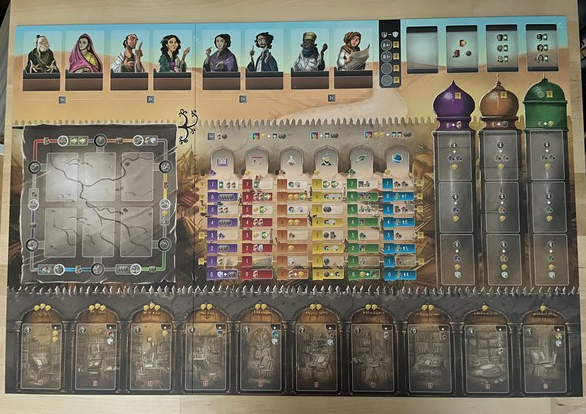
Players will be getting their own player board, action cards, and influence tokens that they will be using to influence the local guilds and also some of the scrolls that are passing through them.

They are essentially nobles or heads of institutions of knowledge, spending money to hire translators as well as trying to have the most influence in these guilds.
They’re also going to get a goal card and a starting scroll based on the translator who’s on the goal card.

Fulfilling these goals will get you two workers and a new die for you dice bag, and also give you a new action card and action space!
They will also, in reverse player order, choose a starting resource card and a starting translator.

These translators are placed in a library room at the bottom of the board with your influence on them. The resources are the number of starting dice in your bag (which you then draw 4 from and roll), gold, silver, workers, and some other bonus (or maybe you’ll just get a bunch of workers and no extra bonus).
On your turn, you are going to be playing one of your action cards to a space on your board.
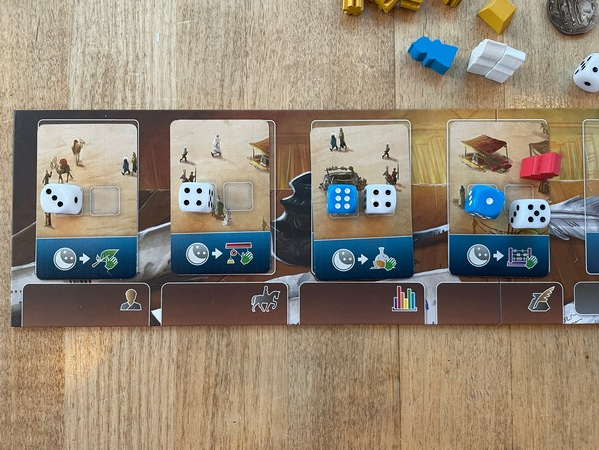
The action cards will have a place to put one or two dice and the space on your board will determine what action you are taking.
What can you do with these action cards?
The first space is hire/dismiss a translator.
At the top of the main board, there are 8 stacks of translators.
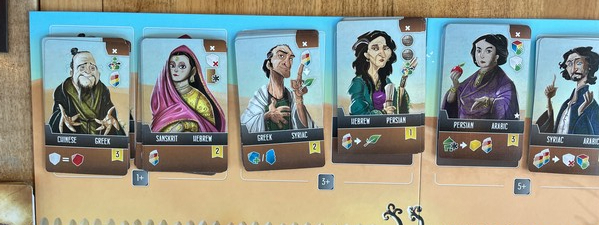
(There are two more off to the right)
Depending on the number of the dice you place on the action, you can interact with one of them. The dice value required can be seen below each pair.
You can hire them, which means they’ll go into their own little room with your influence on them, or you can dismiss them. That puts them at the bottom of their deck (but apparently they have developed cloning technology as the same translator will be on the top of the deck, now just with different abilities!) but you get the benefit in the top right.
The lady who can translate Hebrew to Persian in the middle of the picture will give you two silver and let you draw a die from your bag if you dismiss her.
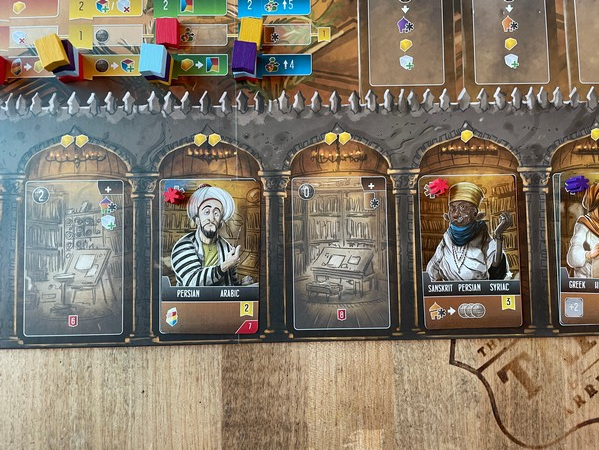
If you hire them, you place them in a room at the bottom of the board, paying the silver cost to place them there, and get the benefit in the top right of the room. Above, the two open rooms cost 2 silver while gaining a guild influence and white die gain (left room) and cost 0 silver and let you influence a scroll (right room).
The second action space is to travel around the world to collect a scroll (or perhaps just resources).

The rectangular track is the map and your piece will move around it the number of spaces based on the number of the dice you put on the action card. The colour of the dice doesn’t matter, except that you get the colour bonus matching the colour of dice you used if you pass over it.
If you land on a white space, you get those resources or do that action.
If you land on a black space, then you are going to be paying 4 silver to move the scroll attached to the space over into one of the guilds.
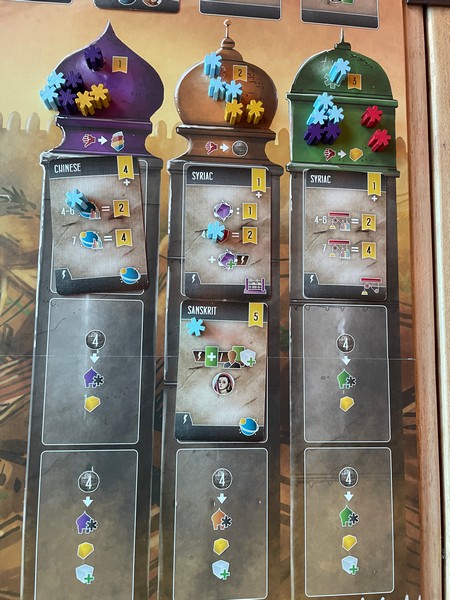
You get guild influence and gold when you do that, depending on the space.
You also move up the scroll’s research track.
What’s a research track?
That’s also the third action you can do.
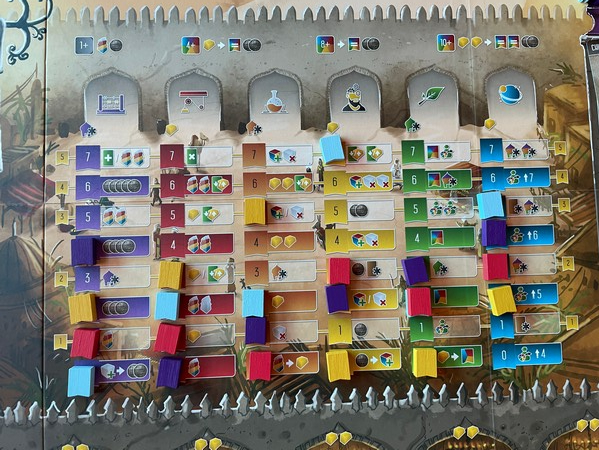
Here’s where colour matters.
So let’s explain how the colours work a little bit.
There are three primary colours (blue, red and yellow) and two secondary colours that can be created by combining two of the primary colours (orange, purple and green).

There are also a few secondary-coloured dice that will let you do it without having to combine dice.
When you are placing dice, you can use white dice or coloured dice to do your action.
However, when colour matters and you only have white dice, you can use workers to make those colours.
You can also use the same colour worker as the die to make that die a 6 no matter what you actually rolled.
If you just use one coloured die, then your dice are that colour. Above, without the blue worker, that would be a Yellow 5.
However, with the blue worker, the white die becomes a blue die.
That’s when you combine the primary colours to get a secondary colour.
Combining yellow and blue makes green.
So that’s now a green 5.
For the research track, that’s what matters, as well as the number.
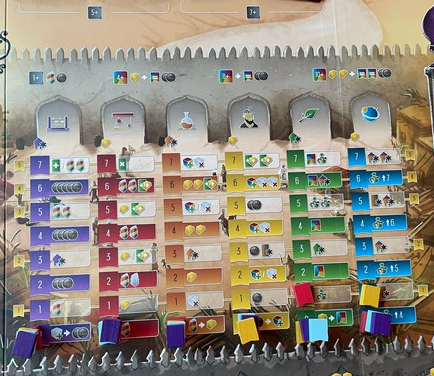
The Research action lets you move up on the track matching your dice colour.
The value of your dice determines how far you move up it and whether it will cost you anything.
If you land on a transparent space, you get that effect immediately.
The solid spaces are for later.
Finally, we get to the meat of the game: translating a scroll.
You have to create a secondary colour with your dice, but the number doesn’t matter.
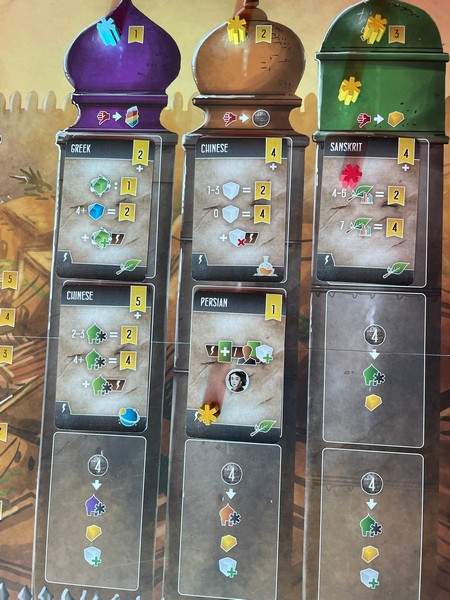
You can then pay translators to translate one of the scrolls in the guild that’s the same colour as your dice.
You do that by finding a chain of translators (or maybe you’ll only need one!) that can get from the language of the scroll to Arabic.
Persian scrolls are easy, usually only requiring one translator.
But Chinese, Sanskrit, Hebrew, and others require a chain.

For each translator you use, you have to pay them a gold (it only costs silver to house them but to actually make them work, it costs gold!).
You then get the research track bonus on the scroll as well as any other immediate effects.
The scroll will also be giving you endgame points.

When translators have gold on them equal to the gold shown above their room, they “retire”.
Whoever actually hired them then places that translator underneath one of the first four actions on their board. This will give them an additional benefit when they take that action next time.

So when she retires, for whatever action the player puts her under, any white die can be considered a yellow die.
And she gets you 3 points at the end of the game!
If you’ve run out of dice or don’t want to continue with the dice you have, you can Rest, which will trigger a new scroll to come out and allow you to harvest the Research tracks based on the action cards you used.
That’s where the solid levels on the tracks mean something, as that is what you get when you harvest them.
This will get you resources, possible allow you to bump up another Research track, or a bunch of other things.
You’ll also draw new dice and get ready for the next turn.
The Caliph cards are the timer of the game.
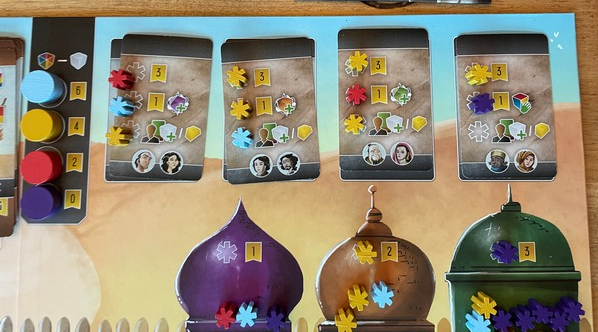
When replacing a scroll, or when resting, if a Caliph card comes out, everything stops for a moment.
This is where whoever controls the guilds currently will be able to get some cool stuff.
Beginning with Purple and going to Green, whoever controls the guild will move one of their influence from the guild to one of the three spaces on the card. This will either get you endgame points, get you one endgame point and die, or let you either get a gold or retire the top translator from one of the two pictured stacks.
If nobody controls a guild, then nobody moves an influence.
Whoever has influence in a guild but not control will get a secondary benefit, which is nice.
Once the fourth Caliph card comes out, the current round is completed to the first player and then everybody gets one more turn.
Total up all the points from the Research track, guilds, scrolls, retired translators, dice sum ranking (the number of coloured dice in your bag minus the white dice you have in your bag)
Whoever has the most points is the winner!
Is Scholars of the South Tigris a crisp new scroll with clear ink that’s easy to read? Or is it a scroll that looks like it was coloured on by a 2-year-old?
Let’s get the red/green elephant out of the way really quickly before going on to everything else.
This is a game about colours, using colours as the basis of almost everything you do.
How colourblind friendly is it?
It’s actually not too bad, though there are still a few issues with at least one of my colourblind friends (though he did manage pretty well, only having to ask a few times if a die was green or orange, for example).
The symbol for all secondary dice has kind of a wavy cloud behind it while the primary colours have just lines.
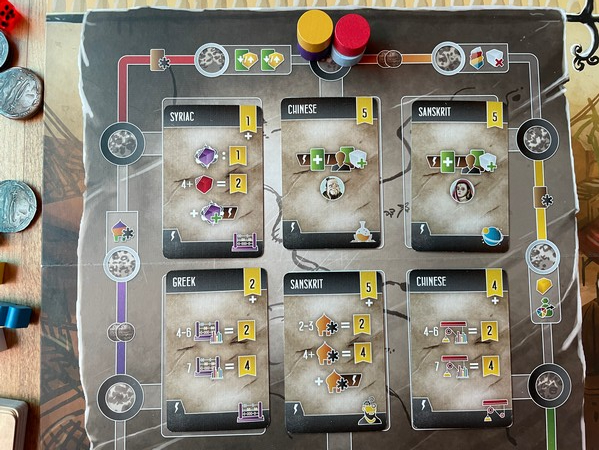
You can see both on the Syriac scroll in the top left.
The purple die symbol has the wavy lines around it while the red die just has lines on the die itself.
That works ok for dice symbols, but the dice themselves?
Secondary colours are translucent while the primary colours are solid. So if you’re red/green colourblind, that shouldn’t be an issue.
But my friend can sometimes have trouble between green and orange, and unfortunately that isn’t solved by making the dice translucent.
Not to mention that while the guilds themselves are in different shapes and you can memorize that the order is “purple/orange/green,” the symbols on the cards for placing influence don’t have different shapes (see the orange Sanskrit scroll above).
If you can’t tell the colour of the guild you’re getting influence in, this isn’t going to help you.
He did occasionally have to ask about the orange and green dice (though having black pips on the orange dice and white pips on the green dice does help with that).
I think Phillips and MacDonald did the best they could considering the fact that this whole game is about colour.
The research tracks are amazing for that, with each having its own symbol as well as colour, so no need to worry about colours there.

It’s also set up to show the primary/secondary combinations really well.
Blue and yellow make green, and the green track is between the blue and the yellow track. The same with the other secondary colours; they are between the two primary colours that create them.
It’s actually quite ingenious.
Ultimately, in a game where colour is so important, it’s not really possible to make everything crystal clear for colourblindness. For the most part it is very accessible.
And my friend won both games he played, so maybe it really doesn’t matter.
(I kid…mostly)
Now that we have the colour issue out of the way, how is the rest of the game?
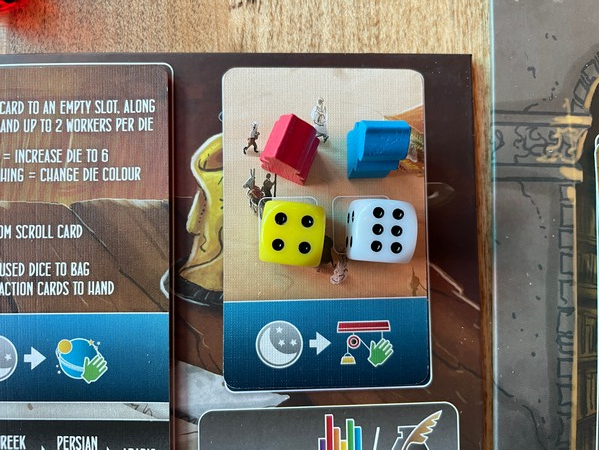
We played it three times in three weeks so I could get a good read on the game, and I really do enjoy it.
It’s similar in weight to Paladins of the West Kingdom, but it doesn’t feel like you’re doing a spreadsheet, which that one can sometimes be.
The decisions you have to make are pretty crunchy, but there are only a couple of paths to victory with a few minor adjustments, so it may not be quite as broad and rich as some of the other ones.
The same friend I’ve been talking about spent most of his time working on the Research tracks and the guilds, translating only one (maybe two) scrolls. Even that scroll was only to complete his goal card.
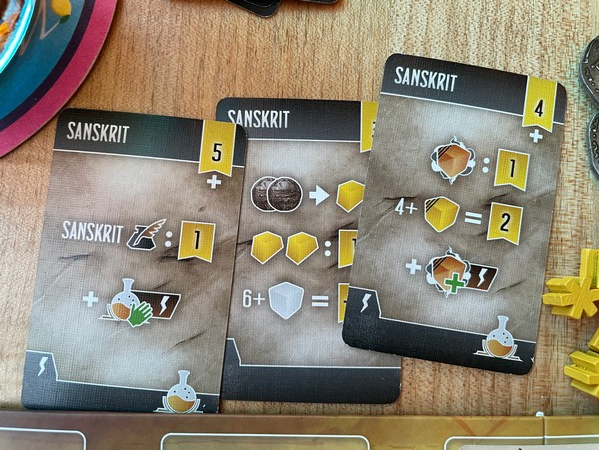
On the other hand, if you do concentrate on scrolls, and using the translators you hire, you can get a lot of points that way and also make your actions more powerful.

Having those translators worth points as well as icing on the cake.
The picture above, doing the Travel action lets you draw a die from your bag. Doing research gives you orange guild influence, and translating a scroll lets you either take a gold from a translator or place a gold on a translator.
That can be quite powerful!
In exactly the same way as Wayfarers (just assume “of the South Tigris” unless I say otherwise, ok?) if you have your influence on something, anybody else who interacts with that something has to give you a silver.
They want to use your translator? Not only do they have to pay the gold to the translator, but they also have to pay you a silver.
They have to pay the boss as well as the employee!
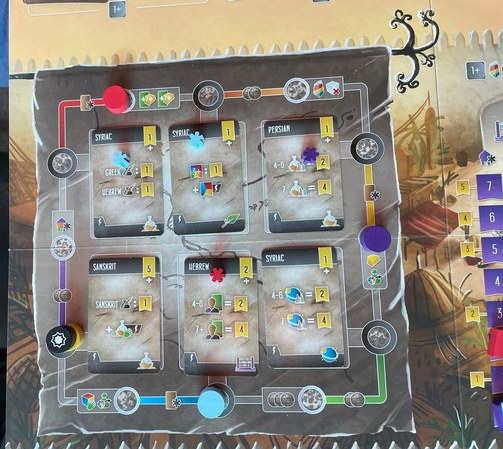
You influenced a scroll? If they want to transfer it to a guild, they have to pay you. Then if they want to translate it, they have to pay you again!
I do like the continuity between games like that. It makes it easier to pick up some of the concepts, even if the main ones change.
This is a dice game, so how is the dice mitigation?
I know some reviews have mentioned how painful it can be to roll low, because some things (like hiring translators or moving up the Research tracks) may require higher numbers.
That’s what the workers are for.
A worker of the same colour as a die can make that die a six.
Yes, that costs you a worker (or two if you also need to change the colour of the die), but in this game, that’s all workers are for!
Workers have no use other than modifying dice.

It is very easy to get at least some workers, and most of the time you can get a worker of any colour (a few places just let you get a white worker).
In many games, workers serve multiple purposes so losing one for dice mitigation could be an issue.
In Scholars, that’s all they do.
Well, they can also be spent when an effect will let you spend a worker to get something.
But that will allow a worker of any colour, and you usually have a bunch of white workers.
I don’t see it as a huge problem because of that, but do keep that in mind. You do need to make sure you are able to get some workers.
Like many deckbuilders and bag builders, the white dice are your “starting cards” and it’s good to get rid of them.
At the end of the game, if you have 6 or more white dice, you lose 3 points. Plus, the “dice sum” mentioned above (far above) is your coloured dice number minus your white dice number. The highest difference gets more points, so white dice can penalize you that way too.
That’s why getting some cool things will have a cost of gaining a white die.
The travelling around the map is probably the least thematic thing in the game, but for the most part the game is quite thematic. You’re hiring translators, translating scrolls, having to pay attention to what languages the various translators speak so you can chain them.
But travelling the map?
Yes, that’s how you get scrolls to the guild (which is thematic), but going around in circles like that just doesn’t feel like you’re travelling.
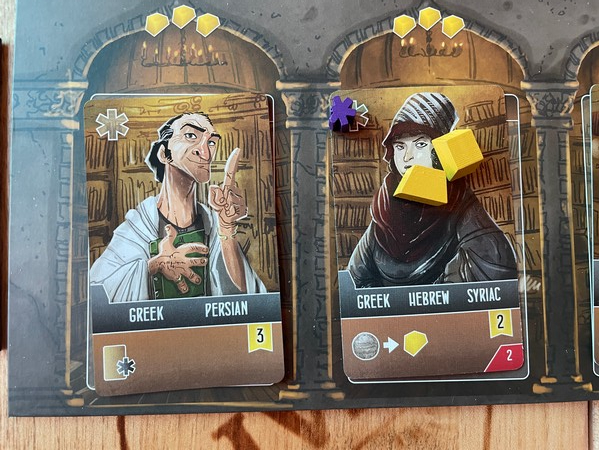
Even having to pay the translators gold (separate from paying a silver if the translator is actually working for somebody else) is thematic. Why would they work for free?
And once they have earned enough, why wouldn’t they retire?
(My friend likes to say that the “take a gold from a translator” action is stealing from their pension fund)
The teach for the game the first time, when I hadn’t played it before, was actually quite long and involved. It then took us 3 hours for a 4-player game.
However, our second game involved three people who had already played, and it only took 2.25 hours. Our final play was a 4-player game with one new player. The teach was really straightforward and the game took 2.5 hours.
Thus, the box probably lies (90-120 minutes) but it’s not a super-long game.
Not as long as Paladins of the West Kingdom, anyway.
It’s pretty straightforward, overall.
But the decisions are meaty!
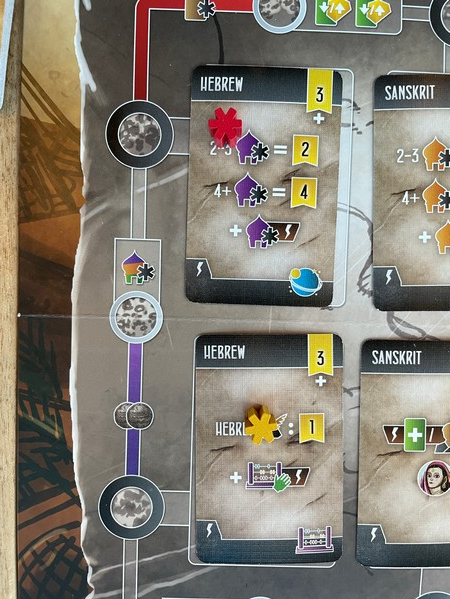
Overall, I have to say that I highly recommend Scholars of the South Tigris, to at least try it. It’s thinky but it’s not unbearably heavy. It has dice but there is a bunch of mitigation (as long as you have workers). Even if you Rest and don’t use all of your dice, you can reroll the remaining ones and hopefully they’ll be better.
The colours can be an issue, but I think they did do a pretty good job of making things easy for that.
Be aware that some forms of colourblindness, you’ll just have to work with them.
In addition to the Research track being a good way to figure out the colours, there is a color guide on the back of the rulebook.
Which does bring up one minor gripe with the game that I have, though given past Garphill games, they must not think it is an issue since they’ve never done it.
This game really could use a couple of player aids that have icons and other things on them.
Yes, the back of your starting resource card does have a sequence of play and such, but being able to refer to a card for the icons (rather than the back of the rulebook) would be very helpful.
Other than that, I really can’t wait to play this one again (though I will give my friends a break and not insist on it for a little while).
Now, if you’ll excuse me, I’m going to go try and learn one of these languages to play the game better!
See you in a few years.
(That really isn’t necessary)
This review was written after 3 plays
Pingback: Review – Shadow Kingdoms of Valeria – Dude! Take Your Turn!
Pingback: December 2023 Gaming – Dude! Take Your Turn!
Pingback: New to Me – December 2023 – Dude! Take Your Turn!
Pingback: Friday Night Shots – Game Promos – Yea or Nay? – Dude! Take Your Turn!
Pingback: Top 50 Games Played of All Time – 2024 Edition (#10 – 1) – Dude! Take Your Turn!
Pingback: Friday Night Shots – Friendship Killing Games – Dude! Take Your Turn!
Pingback: Friday Night Shots – Player Aids – Dude! Take Your Turn!
Pingback: March 2024 Gaming – Dude! Take Your Turn!